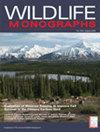Life-history特征of mule deer:营养in a多变环境的影响”鉴定案件sticas historia de vida del ciervo mulo: el Efecto o n nutrici同时在场的一个环境变量性状Biodémographiques骡鹿体内营养的效果:在一个环境变量
摘要
大型食草动物的生长率通常会对资源限制的增加作出反应,其对生命史特征的影响遵循一个递进的顺序,从幼体的存活率,第一次繁殖的年龄,成体的繁殖,到成体的存活率。然而,生活史特征的预期变化应该通过营养状况的变化来实现,营养状况是营养摄入和需求的整合者,主要由身体脂肪的沉积和分解代谢所代表。阐明营养状况的季节性模式及其对个体和种群表现的相对影响,应能增进我们对生命史战略和有蹄类动物种群调节的理解,深入了解现有生境支持种群增长的能力,并能评估死亡率对种群动态的潜在后果。本文收集了雌性骡鹿个体的纵向数据,并将这些数据与环境和种群特征联系起来。我们的目标是为了解这些大型哺乳动物的生活史策略提供营养基础,并为大型食草动物的保护和管理提供帮助。我们研究了一个在美国加利福尼亚州内华达山脉东侧圆谷越冬的骡鹿迁徙种群,该种群受到高度变化的气候和一系列大型食肉动物的捕食。我们在1997-2009年期间集中监测了该种群的营养和生活史特征,因为它从1985-1991年发生的种群崩溃中恢复过来。圆谷的鹿迁徙到内华达山脉(Sierra crest)峰顶两侧的高海拔夏季山脉,在那里,雨影导致了西侧的mesic和更多的森林,而在塞拉利昂峰顶以东的干旱条件下。2006-2008年犊牛平均成活率为0.33 (SE = 0.091),但犊牛西侧成活率(0.13,SE = 0.092)低于东侧成活率(0.44,SE = 0.11)。母亲的出生质量和营养状况对幼崽的成活率有积极影响;然而,这些影响只对出生在峰顶东部的新生儿明显,那里的捕食压力比西部小。西区幼鼠的主要死亡原因是黑熊(Ursus americanus)捕食(死亡率= 0.63,SE = 0.97),而东区幼鼠的主要死亡原因是犬科动物和野地捕食(0.29,SE = 0.076)。1997-2008年,冠西侧雌鼠秋季平均采食量(0.42,SE = 0.037)低于冠东侧雌鼠(0.70,SE = 0.041),且与个体3月无摄食体脂(IFBFat)呈正相关。在人口水平上,青年与成年女性的比率(1991-2009)变化很大,与当年和前一年成年女性的3月份IFBFat密切相关。一岁雌性的繁殖对夏季(1岁个体)的人均饲料供应敏感,从而影响是否获得足够的排卵体重。在研究期间,窝产仔数保持在较高水平(1.69,SE = 0.027),但受草料可得性的影响为正,受夏季温度的影响为负,且夏季居住在峰顶西侧的雌鼠窝产仔数大于居住在峰顶东侧的雌鼠窝产仔数。相反,怀孕率在多年的研究中保持不变(0.98,SE = 0.005)。盛年雌(2 ~ 9岁)夏季成活率为0.90 (SE = 0.021),冬季成活率为0.94 (SE = 0.012),年成活率为0.87 (SE = 0.025)。尽管历年相对稳定,但冬季和夏季的存活率均受到4月份积雪对种群密度的积极影响。1997-2009年3月成年女性IFBFat平均值为7.2% (SE = 0.077), 2002-2008年11月平均为9.7% (SE = 0.23)。营养状况在影响资源限制和种群性能的因素之间提供了机制联系,因为成年雌性在秋冬后期的状况对个体动物的营养历史(与饲料生长、种群密度、迁徙策略、繁殖成本和营养携带有关)很敏感。3月份雌成虫的营养状况也是来年有限种群增长率(λ)最简洁的预测因子。营养条件对大型草食动物种群生存和繁殖影响的相对大小与预测的资源限制下种群生命率的变化基本一致。研究结果表明,将营养状况指标纳入当前的监测和研究计划,可以改善大型食草动物种群的管理和保护。 我们提供了一种基于种群相对于种群性能的营养状况(称为动物指示性NCC)来估计种群接近营养承载能力(NCC)的方法。种群与动物指示的NCC的接近程度代表了环境支持种群增长的短期能力。监测和管理种群的营养方法与生境的能力有直接联系,减少了估计种群数量或根据种群规模设定目标的需要。我们还提出,死亡率(加性或补偿性死亡率)对种群动态的影响可以通过将估计的生存和幼崽招募的营养能力与经验测量的营养能力进行比较来评估,因为当营养有限时,栖息地产生的幼崽数量超过了栖息地所能支持的数量。我们的方法有助于量化捕食效应,并为确定捕食者控制的有效性以增加有蹄类动物的数量提供依据。©2014野生动物协会。Vital rates of large herbivores normally respond to increased resource limitation by following a progressive sequence of effects on life-history characteristics from survival of young, age at first reproduction, reproduction of adults, to adult survival. Expected changes in life-history characteristics, however, should operate through changes in nutritional condition, which is the integrator of nutritional intake and demands represented primarily by the deposition and catabolism of body fat. Elucidating seasonal patterns of nutritional condition and its relative influence on individual and population performance should improve our understanding of life-history strategies and population regulation of ungulates, provide insight into the capacity of available habitat to support population growth, and allow assessment of the underlying consequences of mortality on population dynamics. We acquired longitudinal data on individual female mule deer (Odocoileus hemionus), and linked those data with environmental and population characteristics. Our goal was to provide a nutritional basis for understanding life-history strategies of these large mammals, and to aid in the conservation and management of large herbivores in general. We studied a migratory population of mule deer that overwintered in Round Valley on the east side of the Sierra Nevada, California, USA, and was subject to a highly variable climate and predation from a suite of large carnivores. We intensively monitored nutritional and life-history characteristics of this population during 1997–2009 as it recovered from a population crash, which occurred during 1985–1991. Deer in Round Valley migrated to high-elevation summer ranges on both sides of the crest of the Sierra Nevada (Sierra crest), where a rain shadow resulted in a mesic and more forested range on the west side compared with xeric conditions east of the Sierra crest. Average survival of neonatal mule deer to 140 days of age during 2006–2008 was 0.33 (SE = 0.091), but was lower for neonates on the west side (0.13, SE = 0.092) compared with those on the east side (0.44, SE = 0.11) of the Sierra crest. Birth mass and nutritional condition of mothers had a positive effect on survival of young; however, those effects were evident only for neonates born east of the crest where predation pressure was less intense compared with the west side. Black bear (Ursus americanus) predation was the main cause of mortality for west-side young (mortality rate = 0.63, SE = 0.97) compared with canid and felid predation for east-side young (0.29, SE = 0.076). Mean autumn recruitment of young during 1997–2008 was lower for females on the west side (0.42, SE = 0.037) than for females on the east side (0.70, SE = 0.041) of the crest, and was affected positively by March ingesta-free body fat (IFBFat) of individual females. At the level of the population, ratios of young-to-adult females (1991–2009) were highly variable and strongly related to March IFBFat of adult females during the current and preceding year. Reproduction by yearling females was sensitive to per capita availability of forage during summer (as 1-yr-old individuals), thereby influencing whether a sufficient body mass for ovulation was obtained. Litter size remained high (1.69, SE = 0.027) during the study, but was influenced positively by forage availability, negatively by summer temperature, and was greater for females that resided on the west side of the Sierra crest during summer than those on the east side. In contrast, pregnancy rates remained unchanged across years of study (0.98, SE = 0.005). Survival of prime-age (2- to 9-yr-old) females was 0.90 (SE = 0.021) in summer, 0.94 (SE = 0.012) in winter, and 0.87 (SE = 0.025) annually. Although relatively stable across years, both winter and summer survival were influenced positively by the preceding April snowpack relative to the density of the population. Mean IFBFat of adult females was 7.2% (SE = 0.077) in March 1997–2009 and 9.7% (SE = 0.23) in November 2002–2008. Nutritional condition offered a mechanistic link between factors that influence resource limitation and population performance, because condition of adult females in autumn and late winter was sensitive to the nutritional history of individual animals as related to forage growth, population density, migratory tactic, reproductive costs, and nutritional carryover. Nutritional condition of adult females in March also was the most parsimonious predictor of finite rate of population growth (λ) during the forthcoming year. The relative magnitude of effect of nutritional condition on survival and reproduction was mostly in accordance with the predicted changes of vital rates in response to resource limitation for populations of large herbivores. Our results indicate that management and conservation of large herbivore populations could be improved by integrating indices of nutritional condition into current monitoring and research programs. We offer a method to estimate the proximity of a population to nutritional carrying capacity (NCC) that is based on nutritional status of the population relative to population performance (termed animal-indicated NCC). The proximity of the population to animal-indicated NCC represents the short-term capacity of the environment to support population growth. A nutritional approach to monitor and manage populations offers a direct link to the capacity of the habitat, and reduces the need to estimate population abundance or set goals according to population size. We also propose that the consequences of mortality (degree of additive or compensatory mortality) on population dynamics can be assessed by comparing the estimated nutritional capacity for survival and recruitment of young to that measured empirically, because more young are produced than what the habitat can support when nutrition is limiting. Our approach is useful for quantifying effects of predation, and provides a basis for determining the efficacy of predator control to enhance ungulate populations. © 2014 The Wildlife Society.

 求助内容:
求助内容: 应助结果提醒方式:
应助结果提醒方式:


